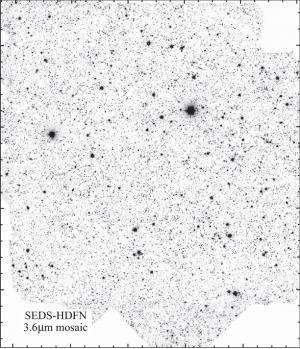The distant cosmos as seen in the infrared

(Phys.org) —At some stage after its birth in the big bang, the universe began to make galaxies. No one knows exactly when, or how, this occurred. For that matter, astronomers do not know how the lineages of our own Milky Way galaxy and its stars trace back to those first galaxies and their first stars, but astronomers have been working hard to find out. The Hubble Space Telescope announced in 1996 that it had stared at apparently dark sky for ten days at optical wavelengths, long enough to acquire a picture of the very distant universe. The resultant image, the Hubble Deep Field (HDF), reveals galaxies that are so far away that they existed when the universe was less than about 5% of its present age of 14 billion years. Since 1996 astronomers have been working to understand exactly what kinds of galaxies these remote objects are, and whether they bear any resemblance to our own Milky Way galaxy, either as it is now, or as it was when it was younger.
CfA astronomers Matthew Ashby, Steve Willner, Giovanni Fazio, Jia-Sheng Huang, Lars Hernquist, Joe Hora, and Howard Smith, along with an international team of colleagues, have just completed an unbiased, deep survey of the distant universe at infrared wavelength using the Infrared Array Camera on the Spitzer Space Telescope. The largest Spitzer science program to date, this survey explored the universe at a depth and over a large field of view never before achieved – nearly six times the area of the full moon and much larger than the original Hubble image. The survey detected galaxies as small in mass as 15% of the Milky Way, and so far away that their light has been traveling for over 12.7 billion years, over 90% of the age of the universe. Within the wide field the team discovered more than 300,000 galaxies.
The new results address four major research goals: a study of galaxy evolution across this dramatic time span, the detection of galaxies with active supermassive black holes at their nuclei in this volume, and variable emission from such nuclei (thanks to the way the survey was executed, with repeated visits to the same regions of the sky to spot changes). Moreover, this deep, wide field allowed the team to study not only galaxies, but the infrared emission from the sky "between" these sources, the so-called diffuse component. Remarkably, the study found that while nearly half of the cosmic infrared light comes from distant galaxies, the other half comes from this diffuse background component whose origin is still not known, though some speculate that it may include light from ensemble of even smaller galaxies. This legacy survey will provide a basis for new research activity for years to come.
Provided by Harvard-Smithsonian Center for Astrophysics















.jpg)





